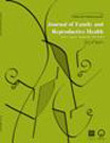فهرست مطالب

Journal of Family and Reproductive Health
Volume:9 Issue: 2, Jun 2015
- تاریخ انتشار: 1394/05/01
- تعداد عناوین: 8
-
-
Pages 45-50ObjectiveInfertility is considered as an intense and prolonged stressful experience. Despite of high prevalence of infertility and its emotional burden for couples and especially for women, the knowledge regarding psychological factors influencing adjustment to it is limited. The aim of the present study was to investigate the mediational role of cognitive emotion regulation strategies in the relationship of ego-strength and adjustment to infertility in women.Materials And MethodsA total number of 275 women with primary infertility referring to Valie-asr Reproductive Health Research Center (Tehran Imam Khomeini Hospital) participated in the present study. Data was collected via demographic information questionnaire, Ego-Strength Scale (ESS), Cognitive Emotion Regulation Questionnaire (CERQ) and Adjustment to Illness Scale (AIS). Data were analysed using Pearson correlation and path analysis methods Using SPSS (18) and LISREL (8.5) software.ResultsResults indicated there are significant positive correlation between ego-strength and adjustment to infertility (r= 0.44, p< 0.01). Also Adjustment has significant positive correlation withadaptive emotion regulation strategies (r= 0.38, p< 0.01) and significant negative correlation with non-adaptive emotion regulation strategies (r= -0.43, p< 0.01). Results of path analysis indicated emotion regulation strategies mediate the relationship of ego-strength and adjustment.ConclusionThese results can be helpful in making preventive policies, identifying high risk patients and planning psychological interventions.Keywords: Infertility, Adjustment, Ego, strength, Emotion regulation
-
Pages 51-57ObjectiveTo determine the effects of Ramadan fasting on serum levels of stress neurohormones in Iranian women with polycystic ovary syndrome (PCOS).Materials And MethodsThis study was a clinical trial and was performed during July 2011(month of Ramadan) in Royan institute, Tehran. A total of 40 women who were aged 20-40 years and known cases of PCOS and had no other medical diseases were included in the study. They were divided into two groups as follows: (i) study group (n=20) who participated in Ramadan fasting and (ii) control group (n=20) who did not participate in fasting. For evaluating Ramadan’s effect on the level of neurohormones serum level of the following variables were evaluated before and after Ramadan: cortisol, adrenaline (A), noradrenalin (NA), beta-endorphin (β-End), insulin, as well as sex hormones including follicle-stimulating hormone (FSH), luteinizing hormone (LH), and testosterone.ResultsIn the study group after Ramadan serum cortisol and nor-adrenaline levels were significantly lower than the initial levels obtained at beginning of Ramadan (p < 0.05) as compared to control group.ConclusionThis study indicates that Ramadan fasting decreases stress neurohormones in women with PCOS.Keywords: Ramadan Fasting, Polycystic Ovary Syndrome (PCOS), Cortisol, Adrenaline, Noradrenaline
-
Pages 59-64ObjectiveSeveral studies have shown the improving effect of heparin on the outcomes of ART. Moreover, it has been reported that adding heparin in non-thrombophilia patients with RIF is useful.The aim of this study was to evaluate the beneficial effects of heparin on ART outcomes in women with history of recurrent implantation failure (RIF) and without history of congenital or acquired thrombophilia in a randomized, controlled clinical trial (RCT).Materials And MethodsIn this study, 100 patients with a history of two or more failures in implantation in cycles of ART were randomly subdivided into two groups of study and control. Patients of the control group just received the luteal phase support. In the patients of study group, in addition to the routine support of luteal phase following in vitro fertilization (IVF) or intra cytoplasmic sperm injection (ICSI), 5000 units of subcutaneous heparin was administered for 15 days from the day of oocyte pick up. Pregnancy test (β-HCG) was done for patient of two groups 15 days after IVF.ResultsIn the study group, pregnancy test was positive in 16 (32%) patients and negative in 34 (68%) patients. In the control group, pregnancy test was positive in 15(30%) patients and negative in 35(70%) patients. There was no significant difference between two groups for the role of heparin in the pregnancy rate (p= 0.5).ConclusionAlthough the effect of heparin on pregnancy was not statistically significant in this study, with regard to the numerous benefits of this agent, it is recommended to study its effects in further studies with lager sample size.Keywords: Heparin, Recurrent implantation failure, ART, Pregnancy test
-
Pages 65-73ObjectiveOver the last few decades, Bangladesh has made significant progress towards achieving targets for the Millennium Development Goals (MDGs) and women empowerment. This study is aimed at identifying the levels and patterns of women empowerment in relation to health seeking behavior in Bangladesh.Materials And MethodsWe conducted a cross-sectional study among 200 rural married women in Cox’s Bazar district in Bangladesh using multi stage sampling technique and face-to-face interview. Data was collected on socio-economic characteristics, proxy indicators for women empowerment in mobility and health seeking behavior related decision making. Bivariate and multivariate regression analyses were performed to identify associations between women empowerment in relation to health seeking behavior on mobility and decision making, controlling the effect of other independent variables.ResultsThe results showed that only 12% women were empowered to decide on their own about seeking healthcare and 8.5% in healthcare seeking for their children. In multivariate analysis women empowerment in health seeking behavior was higher among age group 25-34 years (OR 1.76,[CI= 0.82-3.21]), women’s education, husband’s education, age at marriage >18 years (OR 6.38,[CI=0.98-4.21]) and women’s working status (OR 16.44,[CI= 0.79-2.71]).ConclusionWomen empowerment enhances their decision-making authority regarding health seeking behavior. Acknowledging and adopting the implications of these findings are essential for an integrated health and development strategy for Bangladesh and achieving the MDGs.Keywords: Women empowerment, Mobility, Decision making, Health seeking behavior
-
Pages 75-81ObjectiveTo evaluate the safety and efficacy of Isosorbide mononitrate (IMN) as a cervical ripening agent prior to induction of labour in term pregnant women.Materials And MethodsA randomized placebo-controlled study was conducted on 100 term singleton pregnancies planned for induction of labour. The participants were randomly assigned to two groups. One group received 40 mg IMN and the other group received 40mg of placebo kept vaginally. The main outcome of this study was to evaluate the efficacy of IMN in cervical ripening based on the change in modified Bishop score and the effect on time duration between the drug insertion and delivery. Safety of isosorbide mononitrate was assessed by measuring variables related to maternal and neonatal outcomes.ResultsBaseline demographic characteristics were similar in both groups. The mean change in modified Bishop score after 2 doses of 40mg IMN was insignificant when compared to placebo. Though IMN shortened the time duration between the drug insertion to delivery when compared to placebo, it was statistically insignificant. The need for oxytocin and 2nd ripening agent was less in IMN group when compared to placebo group but statistically this also proved to be insignificant. It was noted that there was an increase in caesarean deliveries in IMN than in placebo group. IMN did not cause any significant change in maternal hemodynamics and adverse side effects. Though NICU admission and stay was less in IMN than in placebo group, it was statistically insignificant.ConclusionThough IMN did not cause any maternal and neonatal adverse effects, it was found to be inefficient in comparison to placebo as a cervical ripening agent.Keywords: Isosorbide mononitrate, Cervical ripening, Preinduction, Placebo
-
Pages 83-88ObjectiveTo correlate serum estrogen levels with cognitive functions calculated objectively as per Mini Mental State Examination (MMSE) in the females in reproductive age group and those attaining menopause.Materials And MethodsThis study was conducted in Christian Medical College and Hospital, Ludhiana, Punjab, India. 150 subjects (100 postmenopausal females and 50 regularly menstruating females of the reproductive age group) were included. The cognitive functions of all the females and serum estrogen levels (i.e Estradiol E2) were assessed.ResultsThe E2 levels in normal menstruating females were found to be higher (mean = 188.062 pg/ml) as compared to the menopausal females and the difference in E2 levels was found to be significant (p < 0.001). However, the difference in serum estrogen levels of subjects in the two menopausal groups was insignificant. MMSE, showed that scores of normal menstruating females were higher (mean score = 29.92) as compared to post menopausal females for 1-5 years (mean score = 26.72) and post menopausal females for last 6-10 years (mean score = 26.30).ConclusionWe observed that the cognition functions declined in post menopausal women, whereas the scores were higher in the women of reproductive age group, meaning thereby, that it is the serum estrogen level that is bringing about this difference. Another finding was that the decline in cognition following menopause was not progressive. Therefore, this correlation would open up the gates for the use of estrogen therapy for various neuropsychological disorders pertaining to cognition in the postmenopausal females.Keywords: Cognitive function, Post menopausal women, Mini, Mental State Examination, serum estrogen
-
Pages 89-92ObjectiveTo analyze the trend in maternal mortality ratio in a tertiary care centre and the effect of various maternity schemes on it.Materials And MethodsRetrospective analysis of all maternal deaths occurring in the Guru Gobind Singh Medical College & Hospital, Faridkot, Punjab, India was done from Jan 2010 to Dec 2012. Every maternal death was scrutinized from various aspects like direct cause of death, age, locality, antenatal care and gestational age.ResultsThe total number of deliveries has risen from 957 in 2010 to 1063 in 2012 at the same time the maternal mortality ratio has increased from 835.94 in 2010 to 2054.55 per one live birth in 2012.Haemorrhage (24.12%) and sepsis (18.9%) were the most common causes of death followed closely by pregnancy induced hypertension including eclampsia (15.5%). Anemia (12.06%) contributed to the most common indirect cause of death.ConclusionImplementation of the various maternity schemes has had no significant impact on the profile of dying mothers. There is a need to stress the importance of good antenatal care in reducing Maternal Mortality Ratio.Keywords: Maternal Mortality, Maternal Mortality Ratio, Hemorrhage, Anemia, Sepsis, Eclampsia
-
Pages 93-100ObjectiveTo find out whether or not soy milk as a phytoestrogen product can improve the quality of life of the Iranian postmenopausal women.Materials And MethodsParticipants of this randomized clinical trial were 57 healthy postmenopausal women. All eligible women were randomly divided into two groups of soy milk (SG) and control (CG). Individuals in the SG (n=34) received 500 ml soy milk including genistein (28.86 mg/dl) and daidzein (8.25 mg/dl) per day, while the participants in the CG (n=23) received 500 ml low fat cow milk per day during 8 months. Both groups also took daily calcium-D capsules (500 mg calcium and 200 IU D3). The quality of life of all participants was examined twice (at the baseline and the end of the eighth month) using the menopause-specific quality of life (MENQOL) questionnaire.ResultsA total of 57 healthy postmenopausal women with a mean age of 52.13 (3.05) years were included in this study.Despitethe significant but weak difference was observed between SG and CG in the sexual domain score (the mean of percent change: 0.46% vs. 33.94%, respectively; p=0.031),while significant relationship was found between the soy milk consumption and improvement in the domains studied (vasomotor, psychosocial and physical).ConclusionOverall our findings showed that soy milk does not improve the quality of life in postmenopausal women. But to achieve more reliable results, it is recommended further study to be done with a larger sample size, more prolonged, and with participants having severer vasomotor symptoms.Keywords: Quality of Life, Post menopausal, Soy Milk, MENQOL


